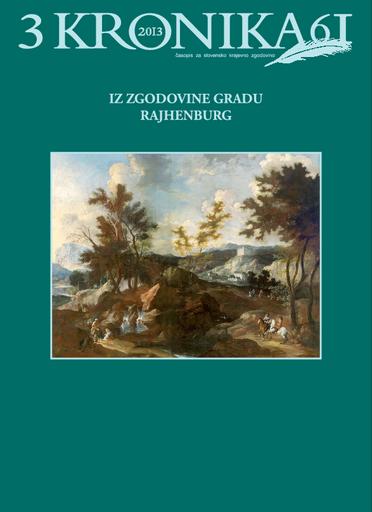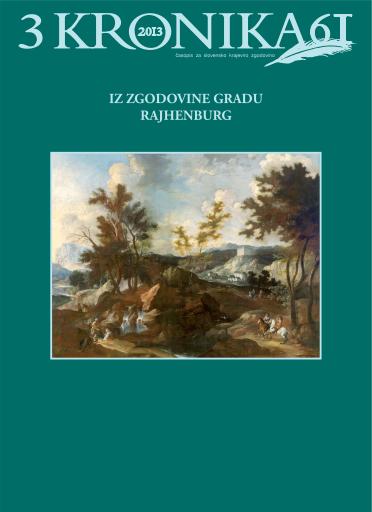/
Serijske publikacije
/
Kronika: časopis za slovensko krajevno zgodovino
Grad Rajhenburg in njegova prenova
Rajhenburg Castle and its renovation

Avtor(ji):Alenka Železnik
Soavtor(ji):Miha Preinfalk (odg. ur.), Barbara Šterbenc Svetina (teh. ur.), Alenka Cizel (prev.), Manca Gašperšič (prev.), Andreja Jankovič Deržič (prev.), Dejan Zadravec (prev.), Lidija Slana (prev.), Meta Osredkar (prev.), Agencija MultiLingual (prev.), Irena Bruckmüller Vilfan (prev.)
Leto:2013
Založnik(i):Zveza zgodovinskih društev Slovenije, Ljubljana
Vir(i):Kronika, 2013, št. 3
Jezik(i):slovenščina
Vrst(e) gradiva:besedilo
Ključne besede:Rajhenburg, grad, prenova, spomeniško varstvo, konservatorstvo, restavratorstvo, Rajhenburg, castle, restoration, monument conservation, conservation, restoration
Avtorske pravice:

To delo avtorja Alenka Železnik je ponujeno pod Creative Commons Priznanje avtorstva-Nekomercialno-Brez predelav 4.0 Mednarodna
Datoteke (1)

Ime:kronika-2013_3.pdf
Velikost:66.73MB
Format:application/pdf
Stalna povezava:https://hdl.handle.net/11686/file18349
Opis
Celostna prenova gradu, pričeta konec aprila 2011 in končana v vsega trinajstih mesecih konec junija 2012,
pomeni uresničenje skoraj pol stoletja trajajočih prizadevanj lokalne skupnosti, države, društev, združenj,
strokovnih inštitucij in njihovih strokovnjakov ter drugih zainteresiranih za prezentacijo in revitalizacijo enega
najstarejših in najpomembnejših gradov na Slovenskem. Zadnja celostna prenova predstavlja nadgradnjo
prenovitvenih posegov, ki so z leta 1976 pričetimi načrtnimi raziskavami in postopnimi prenovami razkrile
stavbni razvoj grajske arhitekture in njegove izjemne spomeniške vrednote. V prispevku je podan pregled
sanacijskih in konservatorsko restavratorskih posegov od njenih začetkov do zadnje celostne prenove.
Metapodatki (12)
- identifikatorhttps://hdl.handle.net/11686/35004
- naslov
- Grad Rajhenburg in njegova prenova
- Rajhenburg Castle and its renovation
- ustvarjalec
- Alenka Železnik
- soavtor
- Miha Preinfalk (odg. ur.)
- Barbara Šterbenc Svetina (teh. ur.)
- Alenka Cizel (prev.)
- Manca Gašperšič (prev.)
- Andreja Jankovič Deržič (prev.)
- Dejan Zadravec (prev.)
- Lidija Slana (prev.)
- Meta Osredkar (prev.)
- Agencija MultiLingual (prev.)
- Irena Bruckmüller Vilfan (prev.)
- predmet
- Rajhenburg
- grad
- prenova
- spomeniško varstvo
- konservatorstvo
- restavratorstvo
- Rajhenburg
- castle
- restoration
- monument conservation
- conservation
- restoration
- opis
- Celostna prenova gradu, pričeta konec aprila 2011 in končana v vsega trinajstih mesecih konec junija 2012, pomeni uresničenje skoraj pol stoletja trajajočih prizadevanj lokalne skupnosti, države, društev, združenj, strokovnih inštitucij in njihovih strokovnjakov ter drugih zainteresiranih za prezentacijo in revitalizacijo enega najstarejših in najpomembnejših gradov na Slovenskem. Zadnja celostna prenova predstavlja nadgradnjo prenovitvenih posegov, ki so z leta 1976 pričetimi načrtnimi raziskavami in postopnimi prenovami razkrile stavbni razvoj grajske arhitekture in njegove izjemne spomeniške vrednote. V prispevku je podan pregled sanacijskih in konservatorsko restavratorskih posegov od njenih začetkov do zadnje celostne prenove.
- The overall renovation of the castle, begun in April 2011 and completed only thirteen months later, at the end of June 2012, signifies the fulfilment of nearly fifty-year efforts by the local community, the state, various societies, association, professional institutions and their experts, as well as other individuals interested in the presentation and revitalisation of one of the oldest and most important castles in Slovenia. The last overall renovation is the continuation of major construction works that have, together with planned research begun in 1976 as well as gradual renovations, shed light on the architectural development of the castle’s architecture and its remarkable monumental value. The paper provides an overview of the rehabilitation and conservation-restoration works from its beginnings to the last overall renovation.
- The first major construction works performed on the castle in the second half of the 1960s and the 1970s, in connection with the setting up of a museum exhibition on Slovenian exiles, contributed to an increased interest in the castle and its revitalisation. The year of 1975 marked the beginning of a gradual renovation of the castle as well as the beginning of the first planned architectural and archaeological research, which revealed the main outlines of the castle’s architectural development and monumental importance. The period of 1976– 1993 saw the renovation of the rooms in the first floor of the eastern tract, where Renaissance frescos were discovered and restored, the rooms in the first floor of the western and southern tracts, and the residential tower, where two permanent exhibitions were set up, one on political prisoners and interns and the other on Trappist monks. Partial restoration was carried out on the Gothic chapel with a Romanesque portal in the southeastern tower; archaeological finds were presented in the courtyard and decorative frescos of the facades were reconstructed. In 1993–2004, the denationalisation process brought the restoration works to a halt. After the said process was completed, the Municipality of Krško as the owner of the castle commissioned project documentation, on the basis of which an overall renovation of the castle commenced in April 2011. The construction, installation, artisanal and restoration works on the castle and the outer ward area, performed along with archaeological and architectural research, were brought to completion after no more than thirteen months, in June 2012. The castle’s exterior with roofs, external and courtyard facades, and the arcade courtyard were completely renovated; all stone elements were restored and partly reconstructed. Most rooms in the castle were given new plasters and floors, all furnishings were changed, the infrastructure was arranged and all stone elements restored. In the outer ward area, the moat with a stone bridge was presented with the tearing down of secondary works and the removal of layers of fills. During the architectural and archaeological research, a series of important and outstanding architectural elements were uncovered, especially from the time when the Romanesque castle was built and extended in the first third of the 16th century, which contributed to the improved and partly even changed the knowledge of the castle. The uncovered material remains were restored and – in the ruined or remodelled parts – reconstructed. With the presentation of the Romanesque southeastern tower with its unique chapel, part of the Romanesque palatium, the Romanesque vestibule, as well as the late Gothic portals and window frames, the castle has strengthened its narrative power and with its already uncovered and restored Renaissance frescos, affirmed its reputation as one of the oldest and most important castles in the Slovenian territory.
- založnik
- Zveza zgodovinskih društev Slovenije
- datum
- 2013
- tip
- besedilo
- jezik
- Slovenščina
- jeDelOd
- pravice
- licenca: ccByNcNd
